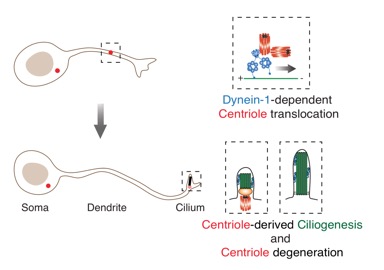|
Prof. Guangshuo Ou’s group from the School of Life Sciences at Tsinghua University published a paper entitled “Centriole translocation and degeneration during ciliogenesis in Caenorhabditis elegans neurons” on The EMBO Journal on July. 25th, 2017. Their work showed that Ciliogenesis in Caenorhabditis elegans sensory neurons requires dynein-1 dependent dendritic translocation of the centriole to position centriole©derived basal body that forms a template for cilium formation.
Our perceptions of the natural world originate from our senses of an unending variety of stimuli in the environment. Sensory organs have developed specialized structures to perform this feat. Neuronal cilia that are formed at the dendritic endings of sensory neurons are essential for sensory perception. However, it remains unclear how the centriole-derived basal body is positioned to form a template for cilium formation. Using fluorescence time-lapse microscopy, Prof. Ou and his colleagues found that the centriole translocates from the cell body to the dendrite tip in the Caenorhabditis elegans sensory neurons. The centriolar protein SAS-5 interacts with the dynein light-chain LC8 and conditional mutations of cytoplasmic dynein-1 block centriole translocation and ciliogenesis. The components of the central tube are essential for the biogenesis of centrioles, which later drive ciliogenesis in the dendrite; however, the centriole loses these components at the late stage of centriole translocation and subsequently recruits transition zone and intraflagellar transport proteins. Their results provide a comprehensive model of ciliogenesis in sensory neurons and reveal the importance of the dynein-dependent centriole translocation in this process.

Fig. 1. The proposed model of Centriole translocation and degeneration during ciliogenesis
Prof. Ou from the School of Life Sciences at Tsinghua University is the corresponding author. Postdoc Wenjing Li is the first author of this paper. Prof. Haiteng-Deng and Wenhao Zhang from the Center for Biomedical Analysis of Tsinghua University performed the Mass spectrometry analysis. Peishan Yi, Zhiwen Zhu, Xianliang Zhang and Dr. Wei Li from the School of Life Sciences at Tsinghua University participated in this project. This research was funded by Tsinghua-Peking Center for Life Sciences, the National Natural Science Foundation of China and the National Basic Research Program of China.
Paper link: http://emboj.embopress.org/content/early/2017/07/25/embj.201796883
|
